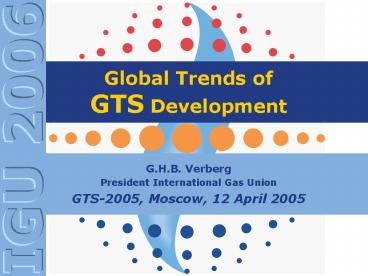Global Trends of GTS Development - PowerPoint PPT Presentation
1 / 28
Title:
Global Trends of GTS Development
Description:
Long distances to cover (Iran-India 2775 km, investment $4b; Alaska-Chicago 5000 km; ... Third parties and regulators claim relevant information of GTS for ... – PowerPoint PPT presentation
Number of Views:226
Avg rating:3.0/5.0
Title: Global Trends of GTS Development
1
Global Trends of GTS Development
- G.H.B. Verberg
- President International Gas Union
- GTS-2005, Moscow, 12 April 2005
2
INTERNATIONAL GAS UNIONCovers gt95 of World Gas
Sales Spokesman of the Gas Industry
www.IGU.org
Membership from 67 countries and 18 Associated
Members
Non Members
3
Global Trends of GTS Development (1)
- Tracking the strong growth in gas demand by
timely investments - Complying to modern safety and environmental
standards - Conditioning for (almost) real time information
flows for regulators and third parties - Implementing management systems, including PIMS,
which enables management also to handle
benchmarking.
4
Demand not in regions of supplies
- Fuel demand increases steadily general economic
growth (developed markets), fast growing
emerging economies (Asia) - New gas fields lie in remote areas and require
long distance transport - New gas supply projects are technically and
geopolitically more complex and more expensive
5
Global Energy Demand Forecast IEA WEO 2004
159
139
118
187
100
100
54
6
Emerging Markets Put Their Mark On Hydrocarbons
Demand
of Global Hydrocarbons Demand for each region
Market Share oil/gas/coal per Region
2002
2020
2020
2002
2002
2020
7
Energy consumption in perspective
1/3 of world population
IEA data year 2002
8
Incremental Global Gas Demand from 2002 to 2010,
2020
largest liquefaction train 7.8 mtpa (Qatar)
148
60
2002 to 2010
2002 to 2020
9
Costs in the LNG chain
Average price per ship ( million)
Upstream costs (/boe)
Liquifaction costst transformed ( per ton of
capacity)
From a presentation by BP (february 2003)
10
LNG trade history and perspectives
15
Bcm
LNG trade as of total gas market
11
8
6
History (CEDIGAZ)
Forecast (IEA weo 2004)
11
International LNG Trade Connecting Markets
12
Transport by pipeline some figures
- Pipelines
- Long distances to cover (Iran-India 2775 km,
investment gt 4b - Alaska-Chicago gt5000 km
- Russian gas fields-W.EU up to 4000km)
13
PIPELINES RUSSIA -gt EUROPE
14
Costs of Transport for Different Routes
15
Moving EnergyGas or Electricity lines ?
- Transmission losses
- Long distance transport
- Per 100 km gas 0,3, electricity 1
- Distribution to end users
- Gas none electricity 7 (stepwise
transformation to lower voltage)
16
Global Trends of GTS Development (2)
- Tracking the strong growth in gas demand by
timely investments - Complying to modern safety and environmental
standards - Conditioning for (almost) real time information
flows for regulators and third parties - Implementing management systems, including PIMS,
which enables management also to handle
benchmarking.
17
CO2 emission from power plants
spread due to type of coal (lignite/hard coal)
and technology (old/new-high-efficiency)
CCGT as Back UP
Sources life-cycle assessment of electricity
generation systems and applications for climate
change policy analysis, Meier, 2002, published on
website Nuclear Energy Institute own data IEA
18
CO2 emission from conventional and modern coal
power plants vs Gas-CCGT
IEA world energy outlook 2004
19
CO2eq Emissions From GTS
20
LOW CO2eq emissions from GTS are drivers in the
competition
21
Global Trends of GTS Development (3)
- Tracking the strong growth in gas demand by
timely investments - Complying to modern safety and environmental
standards - Conditioning for (almost) real time information
flows for regulators and third parties - Implementing management systems, including PIMS,
which enables management also to handle
benchmarking.
22
Information flows not only for own management!
- General public and authorities want reliable and
up to date information at least with respect to
safety, environmental and reliability - Third parties and regulators claim relevant
information of GTS for the use of GTS for gas
transport - Management needs good information systems to
manage in the present complicated business
environment !
23
Global Trends of GTS Development (4)
- Tracking the strong growth in gas demand by
timely investments - Complying to modern safety and environmental
standards - Conditioning for (almost) real time information
flows for regulators and third parties - Implementing management systems, including PIMS,
which enables management also to handle
benchmarking.
24
PIMS, Benchmarking, Regulation
- Pipeline Integrity Management System (PIMS) is a
crucial management tool for GTS - Regulators/Authorities require more and more
public accountability and responsibility for the
performance and management of GTS - Regulators/Authorities introduce more and more
benchmarking to stimulate improvements
25
Benchmarking
- Regulators/Authorities are using benchmarking
more and more - The sale of regional gridsystems by the National
Grid Transco (UK) will facilitate benchmarking
between different grid cies in the UK - In several countries grid cies are being
benchmarked by the regulator to stimulate cost
reduction and to improve performance
(reliability, safety, environment)
26
Thank you, for your attention
- See you in Amsterdam!
- 23rd World Gas Conference and Exhibition
- June 5 9 2006
see you in Busan, South Korea, 23-25 May 2005
at the ICT2005, 7th Congress on ICT in the
Energy Business !!
27
IGU mission
- actively and directly promote the technical and
economic progress of the global gas industry - work towards improving the competitiveness of gas
in the world energy markets, thereby emphasising
sound environmental performance, safety and
reliability - promote transfer of technology and know-how,
serving as a global information clearing house - maximise value to its members and to gas customers
28
IGUs objectives
- Gas as the fuel of choice preceding a sustainable
energy system - (Bridging fuel)
- Promotion of the gas industry as a responsible
corporate citizen - Promotion of technology, industry and customer
focus































